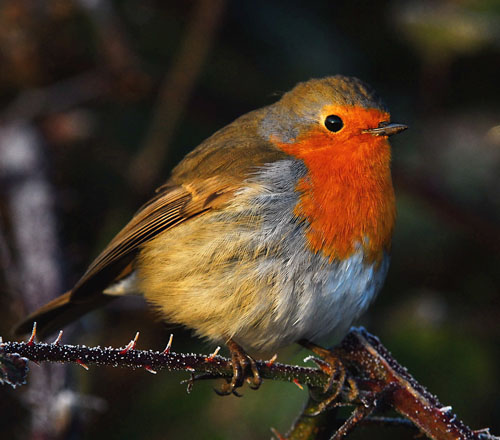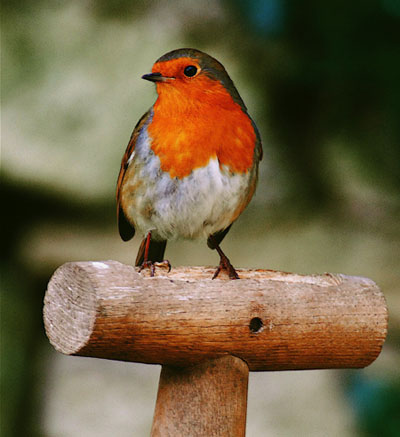
BIRDS OF THE SULGRAVE AREA
(Home)
ROBIN (Erithacus rubecula)

One of the most easily recognised of our birds, officially our native bird and certainly our most loved, the robin needs little introduction. Its presence is perhaps most obvious at this time of year. It’s a regular visitor to the bird table, and the subject of many Christmas cards and calendars. The red breast, the large dark eyes, those spindly legs, its perkiness and, above all, its friendliness endear it to us. Its tameness has long been recognised. In the 6th century, a Scottish saint, St Cerf, fed a robin which perched on his shoulder as he prayed. The 18th century poet James Thompson wrote:
Half afraid, he first
Against the window beats; then brisk alights
On the warm hearth; then, hopping o’er the floor,
Eyes all the smiling family askance,
And pecks, and starts, and wonders where he is –
Till, more familiar grown, the table crumbs
Attract his slender feet.
One has only to start to dig over a patch in the garden for the local robin to appear – on one occasion a robin alighted on my shoulder as I was digging.

The robin is strictly territorial. In winter, each sex defends its own territory, until the two come together for the breeding season. Unusually, both sexes will sing – a sweet rather wistful little song of short liquid phrases – and will sing in winter too, although less often and more subdued.
This bird is well known for its idiosyncratic choice of nest sites. It will often spurn specific robin nest-boxes to build on any ledge or in any nook or cranny: recorded sites include a bedroom pelmet, a church lectern, under the front wing of a sports car, in the engine of a 2nd world war plane, in an unmade bed and in the pocket of a gardener’s jacket (most of these, with the co-operation of the owners/users, were successful).
To us British, the idea of eating robins may seem abhorrent, but robins are caught and eaten in other parts of Europe (and in fact were so in Britain in the past). Much more usual is the protective attitude reflected in Blake’s “A robin redbreast in a cage / Puts all heaven in a rage” or the saying “Kill a robin or a wren / Never prosper boy or man”. Despite its cuddly reputation, the robin is quite an aggressive little bird, and will drive off tits and sparrows from the food on the bird table. Its place in our affections is, however, unassailable.
Photos: John Sheppard. Text: George Metcalfe.
See Bird Archive for other birds in this series.